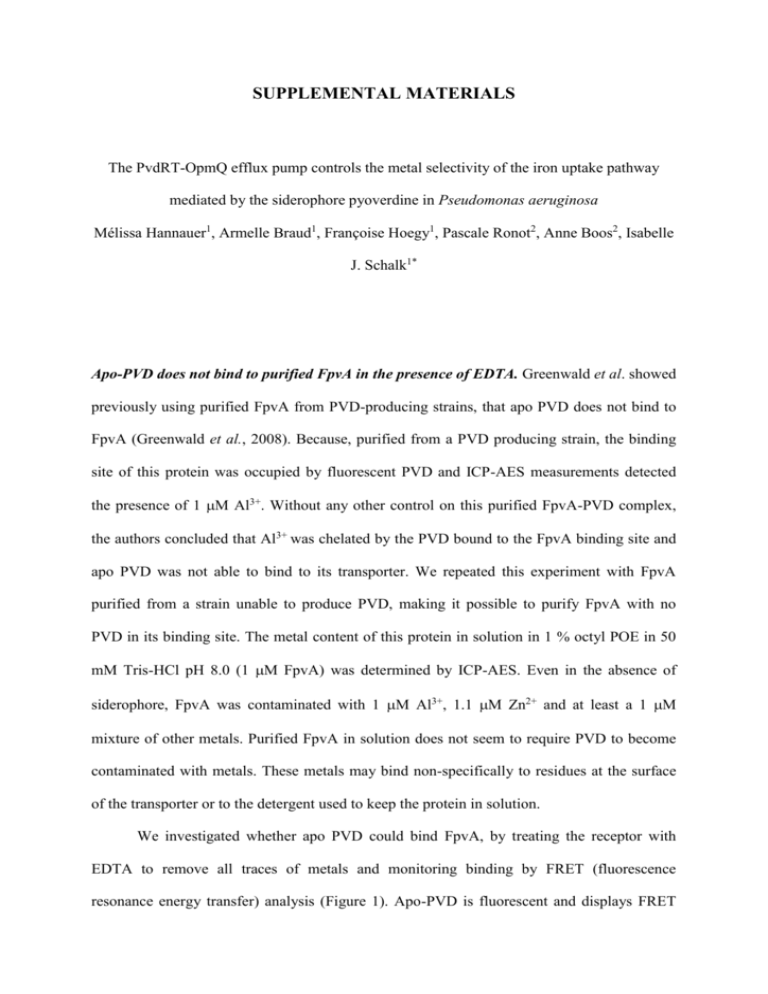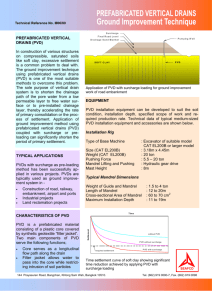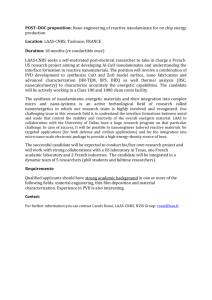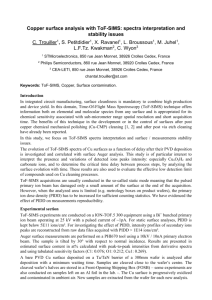supplemental materials
advertisement

SUPPLEMENTAL MATERIALS The PvdRT-OpmQ efflux pump controls the metal selectivity of the iron uptake pathway mediated by the siderophore pyoverdine in Pseudomonas aeruginosa Mélissa Hannauer1, Armelle Braud1, Françoise Hoegy1, Pascale Ronot2, Anne Boos2, Isabelle J. Schalk1* Apo-PVD does not bind to purified FpvA in the presence of EDTA. Greenwald et al. showed previously using purified FpvA from PVD-producing strains, that apo PVD does not bind to FpvA (Greenwald et al., 2008). Because, purified from a PVD producing strain, the binding site of this protein was occupied by fluorescent PVD and ICP-AES measurements detected the presence of 1 M Al3+. Without any other control on this purified FpvA-PVD complex, the authors concluded that Al3+ was chelated by the PVD bound to the FpvA binding site and apo PVD was not able to bind to its transporter. We repeated this experiment with FpvA purified from a strain unable to produce PVD, making it possible to purify FpvA with no PVD in its binding site. The metal content of this protein in solution in 1 % octyl POE in 50 mM Tris-HCl pH 8.0 (1 M FpvA) was determined by ICP-AES. Even in the absence of siderophore, FpvA was contaminated with 1 M Al3+, 1.1 M Zn2+ and at least a 1 M mixture of other metals. Purified FpvA in solution does not seem to require PVD to become contaminated with metals. These metals may bind non-specifically to residues at the surface of the transporter or to the detergent used to keep the protein in solution. We investigated whether apo PVD could bind FpvA, by treating the receptor with EDTA to remove all traces of metals and monitoring binding by FRET (fluorescence resonance energy transfer) analysis (Figure 1). Apo-PVD is fluorescent and displays FRET with the tryptophan residues of proteins (Folschweiller et al., 2002; Schalk et al., 1999). Fluorescence at 450 nm should therefore be observed when PVD is bound to FpvA (excitation wavelength 290 nm). EDTA-untreated FpvA bound “apo PVD” and the fluorescent PVD-Ga, as described previously with different kinetics (Clément et al., 2004). EDTA treatment slightly decreased the kinetics of “apo PVD” binding to FpvA but not that of PVD-Ga binding. The experiment was repeated with EDTA-treated FpvA still in the presence of excess EDTA. PVD-Ga was still able to bind FpvA (PVD probably having a higher affinity for Ga3+ than EDTA), whereas binding was no longer observed for apo PVD, confirming that the metal-free form of PVD cannot bind the transporter. Figure SM 1: Binding of PVD-Ga and “apo PVD” to purified FpvA treated with EDTA. 0.5 M FpvA solubilized in 1% octyl POE in 50 mM Tris-HCl pH 8.0 was purified from a strain unable to produce PVD. FpvA was incubated in the presence of 0.5 M PVD-Ga () or “apo PVD” () and fluorescence was monitored at 450 nm (excitation at 290 nm) as a function of time. The same experiment was repeated with EDTA-treated FpvA (PVD-Ga, ; “apo PVD”, ) and with EDTA-treated FpvA still in solution in the presence of 1 mM EDTA (PVD-Ga, ; “apo PVD”, ). Figure SM 2: Fluorescence spectra for 2 M PVD-metal complexes in 50 mM Tris-HCl pH 8.0. Excitation at 400 nm. Figure SM 3: Fluorescence spectra for 2 M PVD-metal complexes in 200 mM Tris-HCl, pH 8.0, sucrose 20 %. Excitation at 400 nm. Figure SM 4: Fluorescence spectra for 2 M apo PVD in 50 mM Tris-HCl pH 8.0 in the presence or absence of a 50- and 100-fold excess of desferrichrome. Excitation at 400 nm.










![GaN/Cu[subscript 2]O Heterojunctions for Photovoltaic Applications Please share](http://s2.studylib.net/store/data/012246427_1-83e58ebaf672d520ac9e0488fcab335f-300x300.png)
